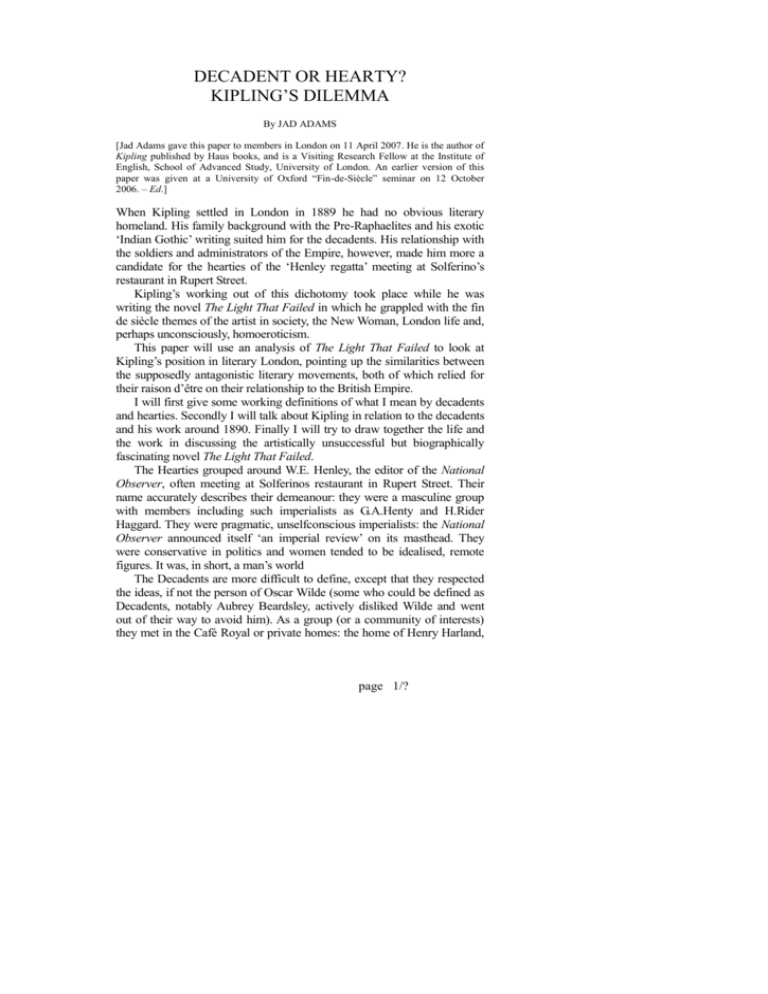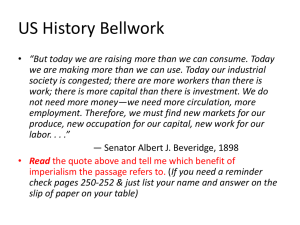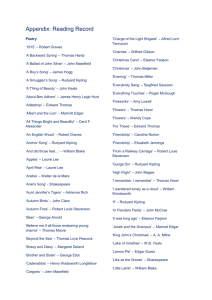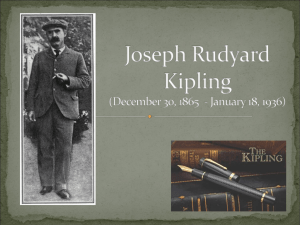- SAS-Space - School of Advanced Study
advertisement

DECADENT OR HEARTY? KIPLING’S DILEMMA By JAD ADAMS [Jad Adams gave this paper to members in London on 11 April 2007. He is the author of Kipling published by Haus books, and is a Visiting Research Fellow at the Institute of English, School of Advanced Study, University of London. An earlier version of this paper was given at a University of Oxford “Fin-de-Siècle” seminar on 12 October 2006. – Ed.] When Kipling settled in London in 1889 he had no obvious literary homeland. His family background with the Pre-Raphaelites and his exotic ‘Indian Gothic’ writing suited him for the decadents. His relationship with the soldiers and administrators of the Empire, however, made him more a candidate for the hearties of the ‘Henley regatta’ meeting at Solferino’s restaurant in Rupert Street. Kipling’s working out of this dichotomy took place while he was writing the novel The Light That Failed in which he grappled with the fin de siècle themes of the artist in society, the New Woman, London life and, perhaps unconsciously, homoeroticism. This paper will use an analysis of The Light That Failed to look at Kipling’s position in literary London, pointing up the similarities between the supposedly antagonistic literary movements, both of which relied for their raison d’être on their relationship to the British Empire. I will first give some working definitions of what I mean by decadents and hearties. Secondly I will talk about Kipling in relation to the decadents and his work around 1890. Finally I will try to draw together the life and the work in discussing the artistically unsuccessful but biographically fascinating novel The Light That Failed. The Hearties grouped around W.E. Henley, the editor of the National Observer, often meeting at Solferinos restaurant in Rupert Street. Their name accurately describes their demeanour: they were a masculine group with members including such imperialists as G.A.Henty and H.Rider Haggard. They were pragmatic, unselfconscious imperialists: the National Observer announced itself ‘an imperial review’ on its masthead. They were conservative in politics and women tended to be idealised, remote figures. It was, in short, a man’s world The Decadents are more difficult to define, except that they respected the ideas, if not the person of Oscar Wilde (some who could be defined as Decadents, notably Aubrey Beardsley, actively disliked Wilde and went out of their way to avoid him). As a group (or a community of interests) they met in the Café Royal or private homes: the home of Henry Harland, page 1/? editor of the Yellow Book, at 144 Cromwell Road; the home of Aubrey and Mabel Beardsley and their mother at 114 Cambridge Street; and at Mabel Dearmer’s ‘lurid Mondays’ at 9 Davenport Street. The men were feminine or feminised males if not actually homosexual, at home with the world of women – Wilde himself edited Woman’s World from 1887 to 1889. The women to be found in Decadent circles were ‘modern’, but supporting the various notions of female emancipation current in the 1890s was not a defining characteristic of Decadence, the point is that a New Women could move among the Decadents and not feel out of place. Artistically, the Hearties’ work was a response to the working out of Britain’s imperial mission, while the Decadents tended to look to France for artistic inspiration. For the Hearties art had a function in society, often a moral function, for the Decadents the motto was art for art’s sake. To quote the famous preface to The Picture of Dorian Gray, ‘There is no such thing as a moral or an immoral book. Books are well written, or badly written, that is all.’ In terms of artistic lineage, the Decadents grew from the aesthetes of the 1880s who developed from the mid-century Pre-Raphaelites. By background, Kipling was firmly in the Decadent camp: artists predominated in his family, there were no soldiers (unlike the Decadent Lionel Johnson who had three brothers serving in the colonies). His uncle was the great Pre-Raphaelite Edward Burne-Jones and the young Kipling would spend school holidays with him. This was not merely a familial obligation, when he was able to make his own choices about where to live, Kipling took a house next door to Burne-Jones in Rottingdean. Another uncle was Edward Poynter, later Sir Edward Poynter RA. Kipling’s study at school was decorated to give a Pre-Raphaelite effect with pictures, antiques and curios. One of Kipling’s official biographers, Charles Carrington says, ‘He was a decadent. His friends, his teachers, were liberals, his tastes were “aesthetic”, the writers he most admired were the fashionable pessimists.’1 His head teacher Cormell Price was a junior pre-Raphaelite, and friend of the family, and it was probably this family connection that led to Kipling’s being sent to the United Services College at Westward Ho! He was the school poet, not in any sense an athlete. One of his schoolboy verses “Ave Imperatrix”, was imperialist in tone, but it was an imitation of a poem by Oscar Wilde of the same title. Wilde was always loyal to empire and Empress, he was still publicly celebrating Victoria’s Jubilee in 1897 after he had served time at her Majesty’s pleasure. page 2/? LITTLE SUN-BAKED BOOKS Kipling left school at sixteen and went to work as a reporter in India, rejoining his family there. In India the four of them were called The Family Square, of course a play on the British square, the supposedly impregnable battle formation. His father was a junior pre-Raphaelite, a ceramicist and museum curator. His mother was a poet as was his sister Trix Fleming who was also a novelist and had two novels published. Kipling was first to distinguish himself in writing stories about Indian life in the Civil and Military Gazette in Lahore and The Week’s News in Allahabad; and Kipling’s output of stories preceded his appearance in London. Plain Tales from the Hills had been published in England in January 1888 and the Indian Railway Library booklets were also circulated in paper covers, probably from plates sent directly from India as the British versions show the Indian price – one rupee – with the local price of a shilling added across the top. These had given Kipling a reputation among the literary set; Andrew Lang remarked: ‘The books had the strangeness, the colour, the variety, the perfume of the East.’ 2 SOLDIERS THREE: the (literally paper-back) first Indian Railway Library book to be published in Britain (Author’s collection). page 3/? Anjali Arondeker points out how boring and provincial India was thought to be before Kipling.3 Now the East was exotic, it had the flavour of strange delights beloved of the decadents. Dixon Scott looking back on the period in the Bookman in 1912 writes of ‘A delicious insolence of aesthetics’ in Kipling’s work ‘The little sun-baked books from Allahabad seemed if anything more golden than the Yellow Book. The proof of the literary epicure was his palate for the Kipling liqueur….The youngster was bracketed with Beardsley, was bracketed with Max. Mr John Lane began to collect his first editions. Mr Richard Le Gallienne was told off to Bodley Head him.’4 The stories reveal an artist who knows his decadent city, such places as “The Gate of the Hundred Sorrows” where opium is smoked, people like the Hindu widow ‘fairer than bar-gold in the mint…an endless delight…as ignorant as a bird’5. In a style that was to be called Indian Gothic undead natives met their imperial masters on equal terms in a pit for cholera victims6. Kipling described scenes such as that in the house of a magician: ‘In the centre of the room, on the bare earth floor, stood a big, deep, brass basin, with a pale blue-green light floating in the centre like a night-light. Round that basin the man on the floor wriggled himself three times.’7 Such an image would not look out of place in the work of Aleister Crowley whose first book, White Stains, was published by the Decadents’ publisher Leonard Smithers. This is an underground world of the east: of prostitution, opium, murder, inter-racial sex and the occult. Kipling had more in common with his London contemporaries than was obvious to his later critics who wanted to see him as a counter-point to effete aesthetes. Wilde famously ‘feasted with panthers’, the renters and blackmailers of London’s sexual underworld just as, to the disgust of his colleagues at the club, Kipling used to trawl the night-life of the Old City of Lahore to gain his own detailed knowledge of opium dens and brothels. . Kipling arrived in London at the end of 1889, he lived above a sausage and mash shop in Villiers Street, off the Strand, a few paces from Trafalgar Square. Gatti’s music hall was opposite the sausage shop, it was such a part of his life that he mentions being able to just see on to the stage by looking through his window and a skylight of Gatti’s. Kipling used to listen to the cab-men and the music hall girls shouting outside in the street and he sat for hours in Gatti’s listening to the talk of soldiers which he wove into the verses of Barrack-Room Ballads. He must have rubbed shoulders with Arthur Symons, the leading decadent, music hall page 4/? correspondent of the Star, who famously wrote in London Nights, his life is ‘like a music hall.’8 Kipling made a deal with Macmillan’s to take his writing in return for a retainer and his stories and poems began to appear at regular intervals, including “The Courting of Dinah Shadd”, “On Greenhow Hill” and “Without Benefit of Clergy”, all of them tales of damaged or distorted love, and clearly part of Kipling’s working out of the pain and confusion caused by his disastrous love life. W.E. Henley in the National Observer became the first to publish the colloquial soldier-speak poems of Barrack-Room Ballads, starting with “Danny Deever” in February 1890 when such vigorous verse was alien to Victorian sensibilities. In tone, form and subject matter it has strong similarities to Wilde’s “The Ballad of Reading Gaol” of the end of the decade: both are first person witness ballads about the execution of soldiers. Over this year, 1890, Kipling was to supply Henley with some of his most unforgettable verses which show deep sympathy for the common soldier, but are also full of respect for native people: “Gunga Din” who was a better man, “ ‘Fuzzy-Wuzzy’ ” who broke a British square. Poems from this period are thought of as a tub-thumping Imperialism, in fact many are about loss and longing – and some are about sex, such as “Mandalay” of 1890. It contains the refrain On the road to Mandalay, Where the flyin’-fishes play, An’ the dawn comes up like thunder outer China ’crost the Bay! The poem was written to a waltz tune which is one reason for its high musicality; it became a music hall favourite. The events that led to a British soldier’s being stationed in Burma, not hinted at in the poem, were that the Burmese King Thibaw confiscated the British Bombay-Burma company and the British therefore invaded Burma in 1885, deposed the King and occupied the country. The soldier thinks of a lost love: By the old Moulmein Pagoda, lookin’ lazy at the sea, There’s a Burma girl a-settin’, and I know she thinks o’ me; page 5/? He remembers how With ’er arm upon my shoulder an’ ’er cheek agin my cheek We useter watch the steamers an’ the hathis pilin’ teak. This is a love poem then, not only for this Burmese girl but for the East itself Ship me somewheres east of Suez, where the best is like the worst, Where there aren’t no Ten Commandments an’ a man can raise a thirst; By contrast England is colourless and restrained. The speaker hates England, its weather, its scenery, the narrow religiosity of its temperance campaigners, the limited horizons of his own class of people I am sick o’ wastin’ leather on these gritty pavin’-stones, An’ the blasted English drizzle wakes the fever in my bones; Tho’ I walks with fifty ’ousemaids outer Chelsea to the Strand, An’ they talks a lot o’ lovin’, but wot do they understand? Beefy face and grubby ’and— Law! wot do they understand? I’ve a neater, sweeter maiden in a cleaner, greener land! With this rejection of England and Englishness for a better world in the East, one thinks of Tennyson’s exactly opposite sentiments, in Locksley Hall, ‘Better fifty years of Europe than a cycle of Cathay,’ a narrator who is disgusted at the thought of being ‘mated with a squalid savage.’ Tennyson’s characters (one thinks also of the narrator of ‘Maud’) are genuine imperialists, willing to sail abroad to die for their country; Kipling’s soldier doesn’t want to die for his country, he wants to get out of it and live with a lovely girl in the East. This celebration of miscegenation could easily be written by one of the Decadent circle: in Arthur Symons’s London Nights or John Davidson’s Fleet Street Eclogues, though Kipling is a better writer than both of those, and the leading Decadent Richard Le Gallienne spoke highly of it.9 I don’t know of any of the Decadents who specifically repudiate the empire or wrote work as anti-imperialist as, say, the Hearty R.L.Stevenson’s The Ebb Tide or The Beach of Falesa. The Decadents did not disparage the empire, they felt themselves to be the culmination of imperial ambition, a period of luxurious surfeit at the height of empire after which decline was inevitable: a recurring theme in Kipling’s more page 6/? thoughtful pieces. The classic ambiguous tale of empire is, one that first saw the light in the Indian Railway Library series, The Man Who Would be King, a depiction of the bluff, trickery and ultimately self-destructive hubris of empire. Oscar Wilde was still, in 1890, a friend of Henley, and welcome at Henley’s gatherings at his home at 1 Merton Place, Chiswick, but literary life was increasingly polarised and as the nineties progressed, the Hearties or ‘Henley’s Regatta’ came to be the literary coterie in which Kipling found company. Kipling had entered a very male group devoted to the depiction of real or idealised male experiences, in which women were remote figures of romance. The literary world of London seemed wide open to Kipling but he chose his friends carefully, gravitating towards the conservative and the established rather than the avant garde. He wrote a skit which included the lines, But I consort with long-haired things In velvet collar-rolls, Who talk about the Aims of Art, And “theories” and “goals,” And moo and coo with women-folk About their blessed souls.10 Clearly Kipling had the contempt for theory of the self-made man, and the fondness of the Decadents for theories of aesthetics repelled him – as did their eliding the differences between the genders (being long-haired men who talk of their innermost selves with women). It is interesting to consider what Kipling’s life would have been had he been to university as his cousin Stanley Baldwin did, instead of going to work at sixteen. He wrote ruefully of his cousin, ‘I’d give something to be in the Sixth at Harrow as he is, with a university education to follow.’11 Even Henley did not escape Kipling’s scorn, he resisted Henley’s referring to him as ‘one of my young men’ and said to Trix, ‘Henley is a great man; he is also a cripple, but he is not going to come the bullying cripple over me’ 12 There was a genuine affection between them, however, in a spirit of hearty camaraderie Kipling gave Henley a punch ball on which were written the names of all the people Henley disliked: Robertson Nicholl, W.T. Stead, Samuel Crockett, Richard Le Gallienne and others, ‘and these gave zest to his morning exercise.’13 page 7/? page 8/? Henley himself was hardly an unequivocal Hearty. His work was sufficiently modern and French-influenced for Arthur Symons to include him in his essay The Decadent Movement in Literature but when it was written up as a book, the mood had changed and (after having been previously advertised under the earlier title) it was called The Symbolist Movement in Literature and Henley was omitted. Another direct contact with the Decadent world is that Kipling knew Beardsley who of course had been introduced to the London art world by Kipling’s uncle Burne-Jones. He supported Beardsley, intervening when he was sacked as art editor of The Yellow Book in the wake of the Oscar Wilde scandal. 14 Kipling’s own pen and ink pictures are suggestive of Beardsley, which is hardly surprising given the Pre-Raphaelite influences on them both, particularly of early Beardsley before he developed the flamboyant style of his maturity (if one can speak of the maturity of an artist who died at twenty-five). The only book Kipling illustrated himself were the Just So Stories of 1902, the pictures of which make an interesting comparison with Beardsley’s. Kipling’s pictures show both grotesques and isolated people or creatures, giving something of a clue to how he was feeling after the death of his daughter Josephine to whom he had told the stories which he had now written out and was illustrating. One can compare the execution of Kipling’s “The Crab that Played with the Sea” with Beardsley’s cat drawing for Poe’s Tales of 1893; the character Parsee Pestonjee Bomonjee and Beardsley’s picture of his printer Joseph Pennell as a Notre Dame gargoyle; Beardsley’s ape from the Murder in the Rue Morgue and Kipling’s “Animal that came out of the sea and ate up all the food”; the composition of Kipling’s “The Man and his Little Girl-Daughter” with Beardsley’s “Cambridge ABC” for an undergraduate magazine. Richard Le Gallienne, one of the chroniclers of the 1890s and a leading Decadent, who as noted above had been sent to ‘Bodley Head’ Kipling, did so in a critical work published to cash in on Kipling’s fame. He called Kipling one of ‘the true end-of-the-century decadents,’ whose aim was ‘to begin the twentieth century by throwing behind them all that the nineteenth century has so painfully won’ by which he meant ‘democracy, the woman-movement [and] the education of the masses.’ 15 page 9/? page 10/? THE NOVEL THAT FAILED ‘It is unnecessary to dwell on The Light That Failed,’ writes Kipling’s first official biographer, Lord Birkenhead.16 I disagree and have dwelt long on it. The emotional inspiration for the book was Kipling’s love for Flo Garrard. The unobtainable beloved is very much an 1890s theme. Kipling’s longing for Flo as an unobtainable love is not so different from the same sentiments in such Rhymers as Ernest Dowson with his adored “Missie”; W.B.Yeats for Maud Gonne and Arthur Symons for the dancer Lydia. This was not the courtly love of the Middle Ages where the object of devotion was unobtainable because she was already married or her social situation was such that marriage could not take place; in the case of Flo and the other 1890s women they were available and could love the men who adored them, they simply didn’t. To use the vernacular, the girls just didn’t fancy them. Few English writers had become famous through writing short stories and none had scaled great heights. Literary London was watching Kipling to see if he would produce a great novel, and Kipling himself had long been aware that he should be writing a long work to pull his talents together. Fortunately he was commissioned to write a novel by the agent for Lippincott’s Magazine. Lippincott’s showed exceptional dexterity in selecting new writers. The twelve issues of the 1890 magazine features Conan Doyle’s first Sherlock Holmes story “The Sign of Four”; Wilde’s The Picture of Dorian Gray, and, at the end of the year, the start of The Light that Failed. It was Henley’s printing of a negative review of Dorian Gray that led to the split between him and Wilde, remarking that the book was suited for ‘none but outlawed noblemen and perverted telegraph boys.’17 Previously Wilde and he had been friends, this is the point at which camp followers have to take sides. The Light That Failed is by way of Kipling’s working out of the issues involved in the struggle. Kipling laboured under the internal pressure of his professional need to produce a long work against a deadline, and under the emotional charge resulting from the way in which a book of some autobiographical complexity was being written while the story it reflected was being played out in his life. The spark that lit The Light That Failed was the reappearance in Kipling’s life of Flo Garrard. Kipling and Trix had been boarded in England from a young age. This was not exceptional – Vyvyen Brendan’s Children of the Raj of 2005 describes how most English children in India were sent away either to England or to boarding schools within India, so they did not acquire native manners as they grew up. Another boarder, after Kipling had left, was Flo, page 11/? a friend of his sister. Kipling used to visit and fell in love with her when he was fourteen. He believed they were engaged when he left England for India in 1882. A year or so later she broke off the relationship. Kipling’s sister wrote of Flo ‘She refused him more than once – his love took a deal of killing – and I think she half accepted him, or he thought she did.’ 18 As Kipling tells the story in the novel, on some lonely wandering in the London fog on the embankment of the Thames in late he met his love again. As he described it: There was no mistaking. The years had turned the child to a woman, but they had not altered the dark-grey eyes, the thin scarlet lips, or the firmly-modelled mouth and chin; and, that all should be as it was of old, she wore a closely fitting grey dress.19 This was almost certainly not how it happened that the two met again in January or early February 1890. We know he had begged his cousin Margaret Burne-Jones to enquire about Flo at the Slade School of Art, ‘I want to know how she is and what she is doing. . . I want you as quietly and unobtrusively as possible to learn all you can about this girl.’20 Doubtless when he got back to England he made further enquiries about her current whereabouts and contrived to see her. In present day terms: he had been stalking her. In this account I will first say what actually happened to Kipling and then refer to the fictionalisation of the events in the novel where Kipling and Flo appear as Dick and Maisie. When Kipling met Flo again, both in their twenties, she had finished at the Slade School and was due to study further at the Académie Julian in Paris. In the novel the Flo character Maisie’s half-hearted acceptance of Kipling (in the character of Dick) extends to permitting him to visit her on Sunday afternoons and seeking his advice on her work, and this us probably a reasonable representation of their actual relationship. Trix said Flo was ‘naturally cold – her very face and magnolia-petal complexion showed that - and she wanted to live her own life and paint her very ineffective little pictures.’ 21 This is certainly the impression Maisie gives to Dick in the novel, for she shows considerable self-knowledge, when she thinks of herself as being selfish because she is using Dick’s skills while she is unable to give him the love he craves in return. Dick is completely unable to conceive ‘that Maisie should refuse sooner or later to love him, since he loved her.’ 22 Kipling visited Flo at her house in London where she was living with Mabel Price, three years older than her and the daughter of an Oxford Mathematics don. Mabel had studied at the Slade and later in London before going to the Académie Julian with Flo. page 12/? Flo’s indifference to him, her resistance to the display of his abilities, probed a deep wound of loneliness and rejection in Kipling. His parents had abandoned him in the House of Desolation with no justification that was comprehensible to him; now he could not make the girl he loved, love him back. Kipling, irresistibly drawn back to past failures, tried again. As he wrote: That the Dog returns to his vomit and the Sow returns to her Mire, And the burnt Fool’s bandaged finger goes wabbling back to the fire;23 Again, Trix remarked that she did not think that Flo ‘did anything to kill his love; she was simply not attracted by anything he had to offer.’24 Flo was not even particularly interested in the written word – Trix said even her letter writing was poor. Kipling could be one of the best writers in the world, destined to be the first Englishman to won the Nobel Prize, but if his beloved was not moved by literature, that counted for little. Kipling visited Flo in Paris from 24-28 May 1890, where she was living with Mabel Price in the Avenue de Jena. Little is known about this time except that they went to the countryside to sketch and to picnic with friends. Kipling must have manoeuvred the time to allow him some private moments of conversation with Flo for he was never to see her again, and clearly something had transpired between them that ended the relationship and sent Kipling off in the heat of furious creativity. If she had not found it before, Flo had by now definitely discovered her sexual orientation. It is not known whether she told Kipling she was a lesbian; or he worked it out for himself on seeing her intimacy with Mabel; or perhaps never did understand explicitly, except that she rejected his advances and gave him no hope for the future. Soon after his return he wrote, The Light That Failed with a theme drawn from Elizabeth Barrett Browning’s Aurora Leigh but with strongly biographical elements. The book begins with Maisie and Dick, recognisably Kipling and Flo, on a seashore playing with a revolver. They are children companions in bondage boarding in a place familiar as the one where Kipling, his sister and Flo lived. The game on the beach ends in Maisie accidentally discharging the revolver near Dick’s face, an event which is probably the ultimate cause of his later blindness (though other causes are given when it is diagnosed). In the same place, Maisie is talking about her imminent departure from the boarding house and Dick declares his feelings for her and coaxes a kiss for the first time. page 13/? Dick is then seen as a young man in the Sudan campaign, in the camaraderie of masculine company. He is a war artist, demonstrating the possibility of being both creative and a man of action and full of ‘the austere love that springs up between men who have tugged the same oar together’.25 The slaughter of Gordon and the loss of the Sudan to what were considered savages was a burning political issue which was to continue through most of the decade: Kitchener was not ordered to begin the reconquest of the Sudan, a key element of Kipling’s plot, until 1896, six years after the first publication of The Light That Failed, though expeditionary skirmishes on the Sudanese border continued throughout. Dick goes to London where his pictures are attracting attention, and he suffers on a diet of sausage and mash. He meets Maisie in the fog on the Embankment and against his will, ‘every pulse of Dick’s body throbbed furiously and his palate dried in his mouth’.26 He walks beside her and they have a desultory conversation. She has also become an artist, studying in London and France. Kipling made them both artists so as to bridge in his characters some of the distance between himself and Flo, who had so little in common artistically. Dick sees her again and takes her to a print shop where people are admiring his work in the window and the fiercely ambitious Maisie envies his fame. Maisie’s is a tale of ‘patient toil backed by savage pride’ where she struggles on with no success. He declares love but she is dedicated to her work and wants only his advice. In The Light That Failed Maisie is living with a ‘red haired girl’ who is not named and whose relationship with Maisie is indistinct except that she has power over her and seems to despise Dick. She is furious, for example, when Maisie permits Dick a chaste kiss when the two women go off together to France. While Maisie is out of the picture with the red-haired girl a messy subplot takes over: Dick’s friend (really the other love interest) Torpenhow becomes entangled with a prostitute, Bessie, who he helps when he finds her collapsed with hunger. Dick earns her enmity by sending Torpenhow away when she is about to move in with him – suggesting that male friendship is more important than sex with women. Dick finds he is losing his sight and he uses Bessie as a model for his last great picture, of Melancholia, the subject Maisie said she was going off to France to paint. Under the pretext of cleaning up, Bessie destroys the masterpiece. Dick has gone blind and Torpenhow, out of pity for his disabled friend, does not enlighten him. page 14/? In a scene of male intimacy, Torpenhow thrust out a large and hairy paw from the long chair. Dick clutched it tightly, and in half an hour had fallen asleep. Torpenhow withdrew his hand and, stooping over Dick, kissed him lightly on the forehead, as men do sometimes kiss a wounded comrade in the hour of death, to ease his departure.27 Torpenhow goes to France and brings Maisie to Dick but after seeing him blindly displaying his ruined picture she runs out. Maisie is last seen alone in her house in London, ashamed of herself for her treatment of Dick but unable to change; neither a great painter nor a great lover and therefore a failure both as an artist and a woman. Torpenhow and others go off to join in the reconquest of the Sudan, leaving Dick alone in his rooms. While out walking with his landlord, Dick encounters Bessie and she returns to his rooms and soon tells him that she ruined his picture. He determines on a last great gesture. He travels to Egypt and reacquaints himself with the terrain and the army, being shot dead at last as he reaches his beloved friend Torpenhow. The strain of creation under such emotional burdens as Kipling faced saw him overload the plot with implausibilities which show Kipling shrinking in the face of what he had created. He is simply unable to face Maisie’s (and therefore Flo’s) lesbian relationship, and therefore has the red-haired girl confessing love for Dick. Mabel Price made a point of telling Kipling’s official biographer that no such thing had happened, so clearly did she see herself in the picture of the red-haired girl. Kipling wants the love between men to be noble, pure and untainted by sex with women so the reader is expected to believe Torpenhow would rather leave the country at Dick’s bidding than have sex with a willing girl. Finally, there is no way such a noble man as Dick would appear on the battlefield in an enfeebled state which would endanger his comrades by obliging them to care for him. On the other hand, the figure of the heroic, but wounded imperialist riding literally blindly into another desert adventure where he will certainly die is one which could only have been created by Kipling, the great poet of empire. Dick’s life and fatal last ride is also a metaphor for the failing gallantry of nineteenth century man confronting the new woman which makes it a richer and more interesting story than many contemporaries realised. The man-loving and misogynistic nature of the book was not lost on contemporary writers. Max Beerbohm slyly remarks that with its adoration of military men, if we knew only this work of Kipling’s, we should assure page 15/? it was the pen-name of a woman writer, ‘strange that these heroes with their self-conscious blurting of oaths and slang, their cheap cynicism about the female sex, were not fondly created out of the inner consciousness of a female novelist.’ 28 Kipling had wrought his experiences into art: his terror of blindness (a genuine and realistic fear for him given his history of poor sight); but it is also an age-old symbol of sexual impotence: masturbation will make you blind and the evil eye will make you impotent; when Oedipus commits a sexual transgression he does not cut off the offending member but puts out his eyes. Dick’s blindness is therefore a symbol both of his loss of creative power as a visual artist and the surrender of the male force to female will. The light is the light of his eyes but also the light of female love which is betrayed when Flo and Maisie take up a man’s instruments: the smoking gun and the smoking cigarette are both masculine symbols which a woman can hold but in Kipling’s ideal world, should not. Tobacco is taken as a symbol of male bonding: ‘Have you any tobacco’? being an effective password to male intimacy. Dick goes whistling to his chambers with a strong yearning for some man-talk and tobacco after his first experience of an entire day spent in the society of a woman.29 Maisie is recognisably a type who recurs in English novels of the 1890s. Her obvious precursor was in Kipling’s friend Rider Haggard’s adventure She (1887). Kipling’s work was to be followed by many others but notably by Du Maurier’s Trilby (1894, which incidentally features Kipling’s uncle Edward Poynter as one of its bohemian characters), Grant Allen’s The Woman Who Did (1895), and Thomas Hardy’s Jude the Obscure (1895), all with the same maddening, self-directed desirable yet distant modern woman. Flo Garrard continued to live with women and paint pictures, and on the flyleaf of her copy of the book, she wrote If you happen to read this singular, if somewhat murky little story you are very likely to rather wonder if real people could be quite so stupid and objectionable as this crowd. . . Of course its difficult to see oneself as others see you, still m’thinks there’s something somewhat distorted about it all; and that the story does not run its entire length on lines quite parallel with Truth.30 page 16/? She signed herself Maisie. She died a moderately successful artist of 73, having had exhibitions in London and Paris. The pressure of this doomed relationship combined with his routine of work and his intense loneliness to send Kipling into a nervous breakdown. While Kipling was publishing The Light That Failed in different editions he was having a close relationship with Wolcott Balestier, with whom he wrote The Naulahka, a working out of the relationship of the New Woman with a heroic man which ends with surrender in the man’s favour. Balestier died suddenly, and Kipling pretty much immediately proposed to his sister Carrie, they were married shortly after and settled in the U.S.A. His novel is the only lengthy clue to what was happening to Kipling: the way Dick was feeling like a limp-wristed Decadent but acting like a muscular Hearty is a biographical pointer to the dichotomy Kipling was experiencing in London in the 1890s. Gail Ching-Laing Low remarks in White Skins/Black Masks of how ‘this feminised decadent world of death, pain, hedonism, sensual pleasure and sexual revelry is rejected for the alternative healthier and cleaner, military world of male camaraderie.’31 Yet the world of male camaraderie cannot fully displace the woman’s world, the heterosexual world, of decadence. The Light that Failed describes Kipling’s unresolved feelings for women and unresolvable feelings for men – they are unresolvable because the corollary is homosexuality which is unacceptable; love between men must remain pure from the taint of sex. It is in this book that Kipling unequivocally aligns himself as an artist with the hearty and the imperial adventure – but it is an artist who is emasculated and whose art is damaged who goes out to fight. NOTES 1. 2. 3. 4. 5. 6. 7. Carrington, Charles, Rudyard Kipling: His Life and Work, (London: Macmillan 1955) p.74. Andrew Laing, from Essays in Little (1891) reprinted in Green, Robert Lancelyn (ed.) Kipling: The Critical Heritage, (London: Routledge 1971) p.73. Arondeker, Anjali, “Lingering Pleasures, Perverted Texts: Colonial Desire in Kipling’s Anglo-India”. In Imperial Desire: Dissident Sexuality in Colonial Literature, ( Minneapolis Minn: University of Minnesota Press 2003). Dixon Scott in the Bookman Vol. LIII, pp.143-6. Reprinted in Green, op.cit. p.310. Rudyard Kipling, “Beyond the Pale”, Plain Tales from the Hills, (London: Macmillan 1890). Rudyard Kipling, “The Strange Ride of Morrowbie Jukes”, Wee Willie Winkie and Other Stories, (London: Macmillan 1895). Rudyard Kipling, “The House of Suddhoo”, Plain Tales from the Hills, (London: Macmillan 1890). page 17/? 8. 9. 10. 11. 12. 13. 14. 15. 16. 17. 18. 19. 20. 21. 22. 23. 24. 25. 26. 27. 28. 29. 30. 31. Arthur Symons, London Nights, (London: Bodley Head 1895) from “Prologue: In the Stall”. Richard Le Gallienne, Rudyard Kipling: A Criticism, (London: John Lane, The Bodley Head 1900) pp.31-2, 162. Rudyard Kipling, “In Partibus”, Civil and Military Gazette, 23 December 1889. Thomas Pinney (ed.), The Letters of Rudyard Kipling, Vol.1 (London: Palgrave Macmillan 1990) p.80. Lord Birkenhead, Rudyard Kipling, (London: Weidenfeld 1978) p.109. Kennedy Williamson, W.E. Henley: A Memoir, (London: Harold Shaylor 1930) p.276. Matthew Sturgis, Aubrey Beardsley: A Biography, (London: Harper Collins 1998) p.239. Richard Le Gallienne, op. cit. pp.158, 161. Lord Birkenhead, op.cit. p.124. On the previous page he refers to it as ‘The only rotten apple in [Kipling’s] teeming orchard’. Anonymous review in Scots Observer, 5 July 1890. Trix Fleming, Kipling Papers, Kipling Archive, University of Sussex 32/32. Rudyard Kipling, The Light That Failed, (London: Macmillan 1891). Hereafter: TLTF. Thomas Pinney, op.cit. p.111. Ibid. TLTF pp.70. Rudyard Kipling, “The Gods of the Copybook Headings” (1919). Ibid. TLTF p.74. TLTF p.57. TLTF p.191. Quoted in Carrington, op.cit. p.217 TLTF p.121. Harry Rickets, The Unforgiving Minute: A Life of Rudyard Kipling, (London: Chatto and Windus 1999) p.167. Gail Ching-Laing Low, White Skins/Black Masks: Representation and Colonialism, (London: Routledge 1996) p.170. page 18/?








